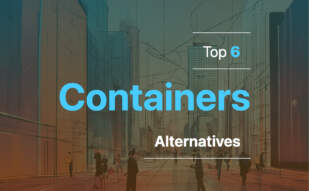Ethereum Virtual Machine is a vital runtime environment in Ethereum for smart contracts, facilitating decentralized operations and state management. It serves as the backbone for executing blockchain transactions securely and immutably.

Looking for alternatives to Ethereum Virtual Machine? Consider exploring WASM, Java Virtual Machine, Docker, and Containers as potential options for your decentralized computing needs.
WASM
Enter the arena of virtual efficiency with WASM (WebAssembly), a game-changing innovation in web development. This W3C standard, rise and shine in 2017, has since influenced web dynamics on a major scale.
WASM Top Features
- Versatility: Supported by all big-name browsers (Chrome, Edge, Firefox, and WebKit).
- Performance: Low level binary format that escalates website performance, boasting new features and considerable performance improvements.
- For Devs, By Devs: WASM’s API and binary format are designed with practical usage and implementation in mind.
- Execution: Runs code in multiple languages on the web at near-native speed.
- Compatibility: Runs alongside JavaScript, empowering web devs to produce high-performing functions more efficiently.
| Feature | Description |
|---|---|
| Serverless applications | Can be applied to serverless environments. Viewed as the problem-solver for serverless adoption troubles. |
| Multi-Language Support | Handles running C, C++, Rust, Python, and Go in-browser. Moreover, languages that compile to WASM include C, C++, Rust, and Go. |
| Enhanced Security | Through reducing the vulnerability attack surface and improving memory safety, the security of applications is enhanced. |
WASM Limitations
- Learning Curve: Can be challenging for beginners due to the low-level nature and binary format
- Not a JavaScript Replacement: While it complements JavaScript, WASM is not designed to replace it completely.
WASM Use Cases
Use case 1: Powerful Web Applications
With WASM, develop web applications that were previously merely dreamy ideals with JavaScript alone. This includes VR/AR, video editing, real-time P2P services, and scientific simulations.
Use case 2: Performance Enhancement
Unleash high-speed, efficient, and portable performance, solving persistent JavaScript performance issues for more extensive and demanding use cases.
Use case 3: Enhanced Security
Meet the requirements of enterprise-grade applications, from memory safety to sandboxing environment, WASM tightens the bolt on application security.
Java Virtual Machine
The Java Virtual Machine (JVM) is an execution program that enables cross-platform compatibility and enhanced performance for Java-based applications. It adheres to the principle – “write once, run anywhere”, and is a pivotal segment of today’s development landscape.
Top Features of Java Virtual Machine
- Portable execution environment: Facilitates the running of Java programs on any device or operating system.
- Enhanced performance: Boosts stability with consistent runtimes, optimizing program memory effectively.
- Language compatibility: Accommodates languages beyond Java, retaining access to Java libraries.
- Memory management: Uses Garbage Collection to liberate unused memory in Java programs.
| Components | JVM specification, implementation, and instance |
| Virtual threads | Intends to introduce for improved coding idioms and performance |
| Class loader | Interprets bytecode and loads compiled .class files into context |
Limitations of Java Virtual Machine
- Absence of components at launch may trigger a JVM launcher error.
- Execution engine, the vital component, could lead to JVM instance termination if it doesn’t function correctly.
Use Cases of Java Virtual Machine
Containerized Development
With JVM’s ability to manage resource usage efficiently, it’s an essential tool for containerized development using technologies like Docker and Kubernetes.
Microservices Architecture
Given its standard configuration, monitoring, and management abilities, JVM aligns well with microservices architecture.
Java-Based Cross-Platform Applications
With its “write once, run anywhere” approach, JVM facilitates the development of Java applications that run on any OS or device, making it invaluable for Java developers.
Docker

Debuting in 2013, Docker rapidly drew global recognition for revolutionizing container technology. A tech titan known for creating the Docker Engine, Docker’s open-source container approach enables software to harmoniously run across varied computing environments. Not just limited to Linux, Docker also supports Windows-based applications.
Top Docker Features
- Container technology: Docker encapsulates codec, runtimes, system tools, libraries, and settings into manageable software units for swift, efficient application deployment.
- Lightweight containers: These standalone, executable software packages leverage a machine’s operating system, thereby helping to reduce server and licensing costs.
- Docker Engine: Giving life to containers and facilitating multiple applications to run on a singular operating system.
- Infrastructure management: Docker disentangles application dependencies from infrastructure, enhancing software delivery speed.
- Security: With a focus on continual enhancement, Docker’s container tech boasts boosted security measures.
| Feature | Description |
|---|---|
| Flexible workflows | Containers align with continuous integration and continuous delivery workflows, ensuring seamless operations. |
| Portability | Workloads can traverse across environments such as physical/virtual machines or cloud providers, offering a high degree of adaptability. |
| Improved resource management | Docker’s containers significantly enhance resource management and efficiency beyond traditional hypervisor-based virtual machines. |
Docker Limitations
- The Docker runtime engine is gradually being replaced by newer engines like containerd and CRI-O.
- Being open-source, Docker can sometimes be outpaced by newer, more feature-rich container platforms.
Docker Use Cases
Scalable Application Deployment
From startups to enterprise-level organizations, Docker offers scalability and the ability to successfully deploy applications across varied computing environments with ease.
Resource Saving
With its lightweight containers sharing a machine’s operating system, Docker is a perfect choice for organizations aiming to optimize server use and cut down licensing costs.
Continuous Integration and Delivery
For teams implementing CI/CD workflows, Docker offers robust support with its seamlessly integrated containers enhancing productivity and operation speed.
Containers

An advanced software solution, Containers, commonly known as sandboxes, ensure smooth, swift deployment while maintaining consistency and security. With the ability to create isolated environments for apps, they remain unaffected by a system’s hardware, operating system, or hosting environment.
Containers Top Features
- High portability of workloads enabled by Docker’s container-based platform
- Multiple containers can run simultaneously on a host promoting isolation and security.
- Docker provides platforms and tools for effective container lifecycle management.
- Containers are lighter and faster than hypervisor-based virtual machines.
- Client-server architecture facilitates communication with the Docker daemon, enabling swift deployment.
| Feature | Benefit |
| Docker Images | Reusable templates in public or private repositories, suitable for creating Docker containers. |
| Specific commands | Docker pull or Docker run commands extract required images from a configured registry, streamlining the process. |
| Namespaces | Provides isolated workspaces known as containers, enhancing Docker’s functionality. |
| Container Security | Docker emphasizes container security, enhancing safety in container-based applications. |
Containers Limitations
- Automatic gathering and publishing of source code is an unsolved issue in Docker’s ecosystem.
- All software, in every layer, needs license conditions when distributing Docker images.
Containers Use Cases
Large Scale Software Infrastructure
Ever since its inception in 2013, Docker, a renowned platform for Containers, has played a crucial part in large scale software infrastructures by facilitating efficient software deployment.
Evolving Container Landscape
The acquisition of Docker Enterprise in 2019 signified notable changes in the container landscape, signifying the importance of Containers in evolving web development environments.
Kubernetes Adoption and Workload Management
Containers play a pivotal role in influencing certain functions within the Kubernetes community, effectively integrating workload management.
Logan Bellbrook
Content writer @ Aircada with a knack for nature & AR/VR/XR. Blogging the intersection of tech & terrain.





